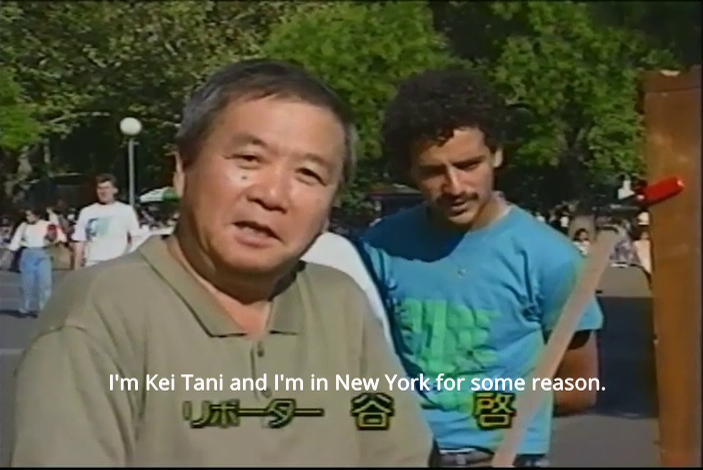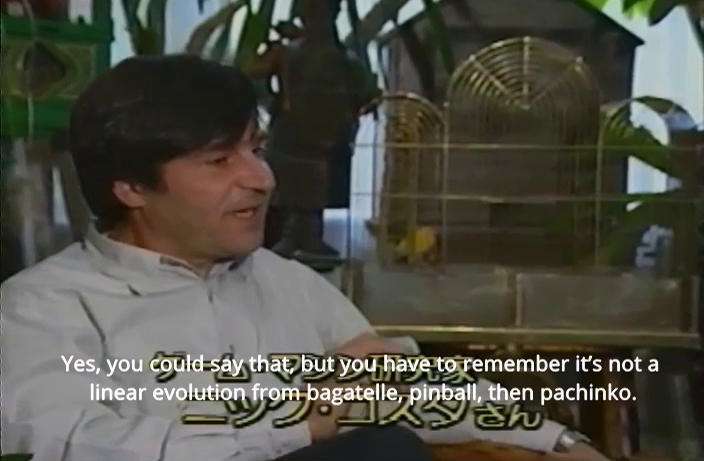Hosted be 谷啓 (Kei Tani,) this aired on Nippon TV January 1992 and features Dick Bueschel (USA), Nic Costa (Cyprus), André Simon (France), and 遠藤嘉一 (Kaichi Endo, Japan,) amongst others.
Annotations provided by Kazuo Sugiyama.
Translation assistance by Ladios.
Thank you Simon Prentis (original English & Japanese interpreter in the TV show) for the video.
Additional notes and editing by Caitlyn Pascal.
I am very excited to share this video with the world. Thank you to everyone who helped make it possible. This is considered the beginning of the modern movement to correct pachinko's history.
A version with just the annotations in Japanese, can be found here:
You can download the version with English subtitles here. It is of slightly better quality, since it has not been re-processed by Youtube.
An "Arcade Exploration" post identifying most of the machines in this video is also available.
Comments from Nic Costa:
I think it's got garbled: perhaps I originally said that the 1890's were when the first coin op drop case games were made in both the UK and US (New York). 1892 was the seminal date in both locations. I think the York reference is to New York not York in England otherwise it doesn't make sense...
Tani Kay showed me a picture of an early machine which he said was in use in Japan in the early days- I knew the machine it turned out to be a machine made by Bolland's Automatic Supply Company in partnership with Charlie Featherstone of the British Manufacturing Company which had been exported to Japan in the mid to late 1920's
 |
| Nic Costa exhibiting an early allwin, in the 1990s |
Mr. Sugiyama traveled to meet Nic in the 1990s, assisted by translator and interpreter Simon Prentis. Simon also acted an interpreter when Nippon TV visited Nic for a TV show on the origins of pachinko, and had worked on the TV program. He had graciously digitized this video from his tape archives.
 |
| Kazuo Sugiyama displaying Nic Costa's latest book, early 2023 |
Dick Bueschel spoke about his experience with this program at Pinball Expo 1992. If you have any recordings of this, please get in touch!
The Spring 1993 issue of Coin Slot magazine gave a summary of Bueschel's talk:
Please note that 谷啓 (Kei Tani) is referred to here as Tanny Kaye. Kei is the family name, so it is still phonetically and grammatically correct.
Dick told us that one day he got a call from a representative of "NTV" (Nippon Television) saying they heard he had a collection of early bagatelle games and asking if he would help them with a TV show. they were doing on the origins of the popular Japanese game of Pachinko.
A representative of NTV then came to visit Dick, we were told, to tell him about the show and make the preliminary arrangements. Dick told a story of him getting roast beef sandwiches for him and his guest to cat, which at first the Japanese man (even though he was a student of cultural anthropology) was afraid to try, but when he finally did, he liked it.
Dick said he was told that the show in question had been on Japanese TV for four years and that each show consisted of a "search" for something or other. For example, one show featured a search for the origins of catsup. and ended up in London. The show's host was a popular Tokyo TV personality who called himself Tanny Kaye, who Dick said was sort of the "Johnny Carson of Japan."
Dick's visitor told him that they were working on a show consisting of a search for the origins of Pachinko. He was then told that the Pachinko industry in Japan was even bigger than their auto industry. Dick was informed that he would be visited by Tanny and his crew to interview him and film his collection of bagatelle games.
Dick then told us that when the crew finally came they first set up their cameras in the street in front of his house and started filming squirrels. When Dick asked about that, they said they thought the squirrels to be "very American. When Dick then asked if they didn't have squirrels in their country, they replied, "No, they were all eaten years ago."
When they finally came into Dick's house, Tanny carrying a large leather bag, Dick was introduced to Tanny. Dick told us that he demonstrated and explained his bagatelle games to Tanny while the TV crew photographed many of the games. The director of the show then asked Dick if they could come back the next day to film his entire collection for display in the Tokyo Cultural Museum. Dick told them that they could.
Before they left, Dick said he asked the director if the TV audience in Japan would understand what he had said since it was in English. He was told there would be no problem because when the show was finally aired he would be speaking fluent Japanese.
Dick then showed the half-hour video of the final show which they sent to him, making comments throughout the showing since the audio was all in Japanese. In addition to Dick's interview (they were right - he spoke fluent Japanese), they showed a visit to a well-known English coin machine collector, Nick Costa, and his impressive collection, and to another collector, in France. It would have been nice to have heard the narration in English, as I am sure it would have been quite interesting, although several Japanese visitors to the Expo had no trouble with that at all.
After the showing, Dick commented that coin machines are really a "multi-cultural thing." He then told us that he thinks the game of Pachinko will become more popular in the United States in the future. Finally, Dick told us that he had been collecting bagatelles since 1965 and that "every one has a story.”
In the video the French collector was just identified as "A. Simon". I checked the classic Les Machines A Sous by Jean Lamaitre, and found an André Simon in the thank-you list. It was later confirmed to me that it is indeed André Simon in the video.
Please share this video and blog post.
 |
| 谷啓 (Kei Tani) |











Awesome find !
ReplyDelete